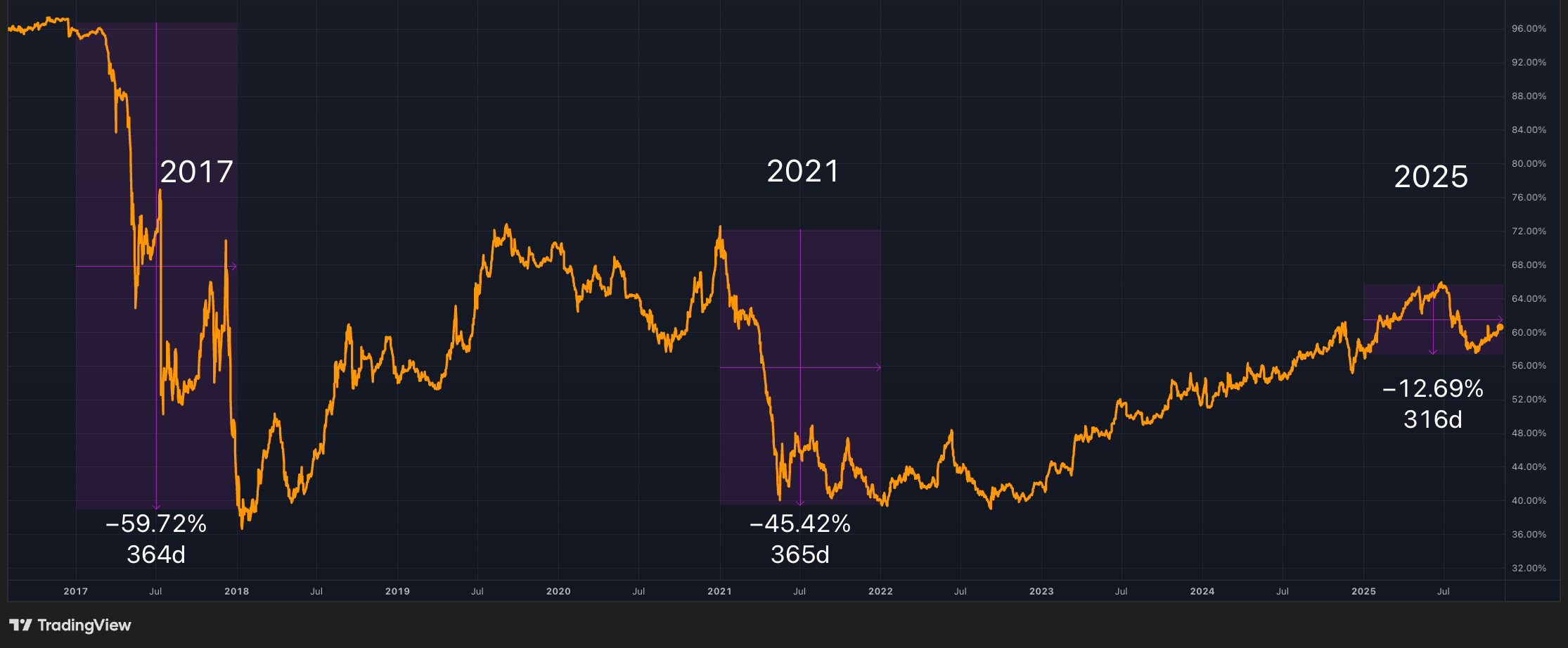November Crypto Market Update: Are Things Different This Time?

Bitcoin (BTC) dipped below $100,000 USD on November 4 and sent market sentiment into a dive. Historical Bitcoin price patterns suggest the final stages of the bull run might be imminent. The prior peak in the 2021 cycle occurred in the second week of November. The 2017 peak landed in the middle of December. The four-year cycle analysis, which has historically guided market timing, suggests the end of the rally could be near, potentially already having peaked when BTC reached $126,000 on October 6th. A year ago, Bitcoin was trading at $66,173. In a rapid six-week surge, it rallied over 60%, hitting a peak of $107,007 on December 17th. The last quarter of 2023 also saw a 40+% price move. So how will 2025 close out? Are things different this time or will there be echos of 2024/2025 winter rallies and the end of the 2017/2021 bull runs?
Key Divergences from Past Cycles: Is the Four-Year Cycle Ending or Just Evolving?
Despite the echo of historical timing, several factors indicate that this bull market has some fundamental differences from 2017 and 2021.
Institutional Adoption & Regulatory Shift: Unlike previous cycles, adoption has significantly expanded to include public markets and major institutional buyers. Crucially, the U.S. regulatory environment has flipped from predominantly negative to positive this year, largely driven by the approval of spot Bitcoin ETFs and clearer regulatory frameworks. This has unlocked deeper pools of capital.
Retail Mania vs. Institutional Infrastructure: One of the key differences this cycle is the adoption from both above (institutions) and below (retail). Technological advances like Pump.fun have dramatically lowered the barrier to entry to create launch tokens and lead to an explosion in new crypto projects (from 5 million to over 26 million in a year). However, this retail-driven speculation is not translating into a broad, market-wide surge like in previous cycles.

The Alts Conundrum: In prior bull markets, a sharp drop in Bitcoin dominance meant capital flowed from Bitcoin into the broader altcoin market and lead to a massive rally across smaller projects. This year, the market has not seen a similar, broad altcoin rally. BTC dominance has remained stubbornly above 50% throughout 2025, suggesting institutions and retail investors are primarily accumulating the most established and regulated asset and leaving altcoins out of their crypto wallets.

Also, the dramatic increase of the number of crypto projects this year has stretched token purchases thinner across the market than in previous bull years. The total crypto market cap reached $4.2 trillion in the first week of October and now sits at about $3.4 trillion. The current total market cap is an increase of only 20% from the all time high in 2021 of $3 trillion. The change from 2017 to 2021 highs was a 307% increase. It seems as though there are more projects competing for a smaller pool of liquidity outside of Bitcoin.

How Are Things Different this Time?
While the narrative of "things are different this time" circulated heavily in 2021, the 2022 crypto winter arrived anyways. What should one consider in late 2025?
For starters, the scale of institutional and regulatory involvement has increased significantly and added new stakeholders as primary drivers. With positive and more clear regulations in the U.S. has also come uncertain and sometimes chaotic geopolitical and macro economic risks.
Prediction markets like Polymarket reflect the current uncertainty, which recently showed implicit probabilities for an end-of-year peak at $130,000 at 45% (a significant drop from 86% in early October) and $140,000 at 26% (as of October 31). A price rally or drop will likely change those “wisdom of the crowd” predictions quickly because they are sensitive to market volatility.
The current cycle appears to be characterized by a flight to quality, with Bitcoin acting as the primary store of value for institutional inflows. This has left speculative altcoins more exposed than in previous runs. The structural changes, U.S. regulatory clarity and institutional adoption, may make any subsequent crypto winter less severe and shorter-lived than the 2018 and 2022 drawdowns. However, the historical four-year cycles (three of them) suggest caution and preparation for a correction or crypto winter soon.
